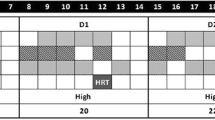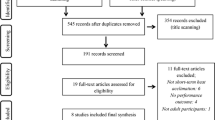Abstract
Extreme environmental conditions present athletes with diverse challenges; however, not all sporting events are limited by thermoregulatory parameters. The purpose of this leading article is to identify specific instances where hot environmental conditions either compromise or augment performance and, where heat acclimation appears justified, evaluate the effectiveness of pre-event acclimation processes. To identify events likely to be receptive to pre-competition heat adaptation protocols, we clustered and quantified the magnitude of difference in performance of elite athletes competing in International Association of Athletics Federations (IAAF) World Championships (1999–2011) in hot environments (>25 °C) with those in cooler temperate conditions (<25 °C). Athletes in endurance events performed worse in hot conditions (~3 % reduction in performance, Cohen’s d > 0.8; large impairment), while in contrast, performance in short-duration sprint events was augmented in the heat compared with temperate conditions (~1 % improvement, Cohen’s d > 0.8; large performance gain). As endurance events were identified as compromised by the heat, we evaluated common short-term heat acclimation (≤7 days, STHA) and medium-term heat acclimation (8–14 days, MTHA) protocols. This process identified beneficial effects of heat acclimation on performance using both STHA (2.4 ± 3.5 %) and MTHA protocols (10.2 ± 14.0 %). These effects were differentially greater for MTHA, which also demonstrated larger reductions in both endpoint exercise heart rate (STHA: −3.5 ± 1.8 % vs MTHA: −7.0 ± 1.9 %) and endpoint core temperature (STHA: −0.7 ± 0.7 % vs −0.8 ± 0.3 %). It appears that worthwhile acclimation is achievable for endurance athletes via both short-and medium-length protocols but more is gained using MTHA. Conversely, it is also conceivable that heat acclimation may be counterproductive for sprinters. As high-performance athletes are often time-poor, shorter duration protocols may be of practical preference for endurance athletes where satisfactory outcomes can be achieved.

Similar content being viewed by others
References
Ely MR, Cheuvront SN, Roberts WO, et al. Impact of weather on marathon-running performance. Med Sci Sports Exerc. 2007;39(3):487–93.
Racinais S, Mohr M, Buchheit M, et al. Individual responses to short-term heat acclimatisation as predictors of football performance in a hot, dry environment. Br J Sports Med. 2012;46(11):810–5.
Sawka MN, Wenger CB, Pandolf KB. Thermoregulatory responses to acute exercise-heat stress and heat acclimation. Compr Physiol 2011;Suppl. 14: Handbook of physiology, environmental physiology 157–85.
Garrett AT, Rehrer NJ, Patterson MJ. Induction and decay of short-term heat acclimation in moderately and highly trained athletes. Sports Med. 2011;41(9):757–71.
Chalmers S, Esterman A, Eston R, et al. Short-term heat acclimation training improves physical performance: a systematic review, and exploration of physiological adaptations and application for team sports. Sports Med. 2014;44(7):971–88.
Taylor NA. Principles and practices of heat adaptation. J Hum Environ Syst. 2000;4(1):10.
Gonzalez-Alonso J, Calbet JA, Nielsen B. Metabolic and thermodynamic responses to dehydration-induced reductions in muscle blood flow in exercising humans. J Physiol. 1999;520(Pt 2):577–89.
Harding S. The tropical agenda. J Tropical Psychol. 2011;1(01):2–5.
Sawka MN, Leon LR, Montain SJ, et al. Integrated physiological mechanisms of exercise performance, adaptation, and maladaptation to heat stress. Compr Physiol. 2011;1:46.
Corbett J, Neal RA, Lunt HC, et al. Adaptation to heat and exercise performance under cooler conditions: a new hot topic. Sports Med. 2014 (In press).
Harrison MH. Effects on thermal stress and exercise on blood volume in humans. Physiol Rev. 1985;65(1):149–209.
Senay LC. Changes in plasma volume and protein content during exposures of working men to various temperatures before and after acclimatization to heat: separation of the roles of cutaneous and skeletal muscle circulation. J Physiol. 1972;224(1):61–81.
O’Sullivan SE. The effects of exercise training on markers of endothelial function in young healthy men. Int J Sports Med. 2003;24(6):404–9.
Sawka MN, Hubbard RW, Francesconi RP, et al. Effects of acute plasma volume expansion on altering exercise-heat performance. Eur J Appl Physiol Occup Physiol. 1983;51(3):303–12.
Cadarette BS, Sawka MN, Toner MM, et al. Aerobic fitness and the hypohydration response to exercise-heat stress. Aviat Space Environ Med. 1984;55(6):507–12.
Shapiro Y, Hubbard RW, Kimbrough CM, et al. Physiological and hematologic responses to summer and winter dry-heat acclimation. J Appl Physiol Respir Environ Exerc Physiol. 1981;50(4):792–8.
Taylor NA, Cotter JD. Heat adaptation: guidelines for the optimisation of human performance. Int SportMed J. 2006;7(1).
Cândido C, de Dear R, Ohba M. Effects of artificially induced heat acclimatization on subjects’ thermal and air movement preferences. Build Environ. 2012;49:251–8.
Saunders AG, Dugas R, Tucker M, et al. The effects of different air velocities on heat storage and body temperature in humans cycling in a hot, humid environment. Acta Physiol Scand. 2005;183:241–55.
Galloway SD, Maughan RJ. Effects of ambient temperature on the capacity to perform prolonged cycle exercise in man. Med Sci Sports Exerc. 1997;29(9):1240–9.
Garrett AT, Creasy R, Rehrer NJ, et al. Effectiveness of short-term heat acclimation for highly trained athletes. Eur J Appl Physiol. 2011;112(5):1827–37.
Armstrong LE, Hubbard RW, DeLuca JP, et al. Heat acclimatization during summer running in the northeastern United States. Med Sci Sports Exerc. 1987;19(2):131–6.
Magalhaes FC, Amorin FT, Passos RL, et al. Heat and exercise acclimation increases intracellular levels of Hsp72 and inhibits exercise-induced increase in intracellular and plasma Hsp72 in Humans. Cell Stress Chaperon. 2010;15:10.
Weller AS, Linnane AG, Jonkman AG, et al. Quantification of the decay and re-induction of heat acclimation in dry heat following 12 and 26 days without exposure to heat stress. Eur J Appl Physiol. 2007;102:57–66.
Edwards AM, Polman RCJ. Pacing in sport and exercise: a psychophysiological perspective. New York: Nova Science Publishers; 2012.
Montain SJ, Maughan RJ, Sawka MN. Heat acclimatization strategies for the 1996 Summer Olympics. Int J Athl Train Ther. 1996;1(3):5.
Mohr M, Krustrup P, Nybo L, et al. Muscle temperature and sprint performance during soccer matches-beneficial effect of re-warm-up at half-time. Scand J Med Sci Sports. 2004;14(3):156–62.
Iwase S, Cui J, Wallin BG, et al. Effects of increased ambient temperature on skin sympathetic nerve activity and core temperature in humans. Neurosci Lett. 2002;327(1):37–40.
Aoyagi Y, McLellan T, Shephard R. Effects of training and acclimation on heat tolerance in exercising men wearing protective clothing. Eur J Appl Physiol. 1994;68(3):234–45.
Aoyagi Y, McLellan TM, Shephard R. Effects of 6 versus 12 days of heat acclimation on heat tolerance in lightly exercising men wearing protective clothing. Eur J Appl Physiol. 1995;71(2–3):187–96.
Brade C, Dawson B, Wallman K. Effect of precooling on repeat sprint performance in the heat. J Sports Sci. 2013;31(7):779–86.
Buchheit M, Voss SC, Nybo L, et al. Phsyiological and performance adaptations to an in-season soccer camp in the heat: Associations with heart rate and heart rate variability. Scand J Med Sci Sports. 2011;21:477–85.
Buono MJ, Heaney JH, Canine KM. Acclimation to humid heat lowers resting core temperature. Am J Physiol Reg I. 1998;274(43):R1295–9.
Chen T, Tsai P, Lin J, et al. Effect of short term heat acclimation on endurance time and skin blood flow in trained athletes. Open Access J Sports Med. 2012;4:161–70.
Cotter JD, Patterson MJ, Taylor NA. Sweat distribution before and after repeated heat exposure. Eur J Appl Physiol Occup Physiol. 1997;76(2):181–6.
Garrett AT, Goosens NG, Rehrer NJ, et al. Induction and decay of short-term heat acclimation. Eur J Appl Physiol. 2009;107(6):659–70.
Marshall HC, Campbell SA, Roberts CW, et al. Human physiological and heat shock protein 72 adaptations during the initial phase of humid-heat acclimation. J Therm Biol. 2007;32:8.
Petersen CJ, Portus MR, Pyne DB, et al. Partial heat acclimation in cricketers using a 4-day high intensity cycling protocol. Int J Sports Physiol Perform. 2010;5:535–45.
Sunderland C, Morris JG, Nevill ME. A heat acclimation protocol for team sports. Br J Sports Med. 2008;42(5):327–33.
Burk A, Timpmann S, Kreegipuu K, et al. Effects of heat acclimation on endurance capacity and prolactin response to exercise in the heat. Eur J Appl Physiol. 2012;112(12):4091–101.
Castle P, Mackenzie R, Maxwell N, et al. Heat acclimation improves intermittent sprinting in the heat but additional pre-cooling offers no further ergogenic effect. J Sports Sci. 2011;29(11):1125–34.
Cheung SS, McLellan TM. Heat acclimation, aerobic fitness, and hydration effects on tolerance during uncompensable heat stress. J Appl Physiol. 1998;84(5):1731–9.
Daanen HAM, Jonkman AG, Layden JD, et al. Optimising the acquisition and retention of heat acclimation. Int J Sports Med. 2011;32(11):822–8.
Houmard JA, Costill DL, Davis JA, et al. The influence of exercise intensity on heat acclimation in trained subjects. Med Sci Sports Exerc. 1990;22(5):615–20.
Lorenzo S, Halliwill JR, Sawka MN, et al. Heat acclimation improves exercise performance. J Appl Physiol. 2010;109(4):1140–7.
Lorenzo S, Minson CT. Heat acclimation improves cutaneous vascular function and sweating in trained cyclists. J Appl Physiol. 2010;109(6):1736–43.
Nielsen B, Hales JR, Strange S, et al. Human circulatory and thermoregulatory adaptations with heat acclimation and exercise in a hot, dry environment. J Physiol. 1993;460:467–85.
Nielsen B, Strange S, Christensen NJ, et al. Acute and adaptive responses in humans to exercise in a warm, humid environment. Pflugers Arch. 1997;434(1):49–56.
Racinais S, Buchheit M, Bilsborough J, et al. Physiological and performance responses to a training camp in the heat in professional Australian Football players. Int J Sports Physiol Perform. 2014;9:598–603.
Sawka MN, Young AJ, Cadarette BS. Influence of heat stress and acclimation on maximal aerobic power. Eur J Appl Physiol. 1985;53(4):294–8.
Voltaire B, Galy O, Coste O, et al. Effect of fourteen days of acclimatization on athletic performance in tropical climate. Can J Appl Physiol. 2002;27(6):551–62.
Acknowledgments
No funding was provided for the preparation of the paper. No author has any conflicts of interest. All authors contributed fully to the preparation of this manuscript.
Author information
Authors and Affiliations
Corresponding author
Rights and permissions
About this article
Cite this article
Guy, J.H., Deakin, G.B., Edwards, A.M. et al. Adaptation to Hot Environmental Conditions: An Exploration of the Performance Basis, Procedures and Future Directions to Optimise Opportunities for Elite Athletes. Sports Med 45, 303–311 (2015). https://doi.org/10.1007/s40279-014-0277-4
Published:
Issue Date:
DOI: https://doi.org/10.1007/s40279-014-0277-4




